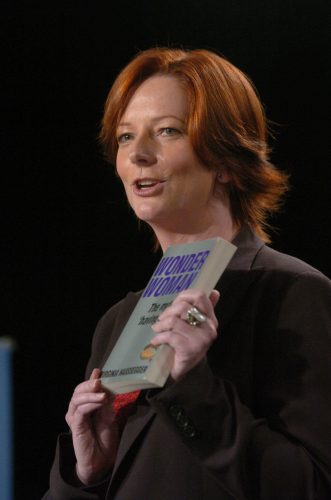Julia Gillard wore big, brave polka dots in her first interview as Prime Minister with Laurie Oakes on Sunday morning. It was an interesting choice. I have no idea if it was deliberate, but I suspect I wasn’t the only woman to smile at the echoes of Joan Kirner.
When the larger than life Kirner became the first – and only – female premier of Victoria 20 years ago, she was quickly plastered with polka dots. Cartoonists had a ball portraying her as a frumpy housewife, of ballooning weight, in a spotty frock.
Ironically, Kirner didn’t even own a polka-dot dress. Yet, in a calculated swipe at her gender, the ridiculous dots sang of female frivolity.
While she was publicly lampooned as the fat, spotted lady, it was hard to take her seriously. But in typical Kirner ”if you can’t beat ’em join ’em” style, she grabbed the gimmick and ran with it. She held a ”Spot on Joan” concert, and declared the spot ”a badge of courage”.
With all that in mind, it was hard not to wonder if Prime Minister Gillard was having a little private joke when she fronted up at Channel Nine in a black blazer with large white polka dots. And was it just coincidence that she wore a matching polka-dot skirt when she went to see Kevin Rudd last Wednesday night?
Gillard has more than ”spots” in common with the legendary Kirner. There’s guts, perseverance and determination – all a given. But their connection goes deeper. They were both founding members of Emily’s List – the financial support network for progressive Labor women. Gillard’s own candidacy is a direct result of that support. And now it’s fair to say her rise to the top is an indirect result of the years of trailblazing by Kirner’s generation – our feminist foremothers.
Only a generation ago, it was inconceivable that the brutish male bastion of Australian politics could be cracked open by women. It was inconceivable that Australia could have several female state leaders or governors; a female Governor-General; a lesbian cabinet minister; or an unmarried, childless female Prime Minister.
As a young journalist in the Victorian press gallery, I was astonished to see Kirner take the helm in 1990 in a state where politics pumped with sweat, testosterone and BLF boots.
It was just six months after Carmen Lawrence had become Australia’s first woman premier as she took the reins in Western Australia, and although both women had been anointed rather than elected as premiers, their appearance on the national stage changed the game remarkably.
Cool, calm and, at times, very softly spoken, the women’s style of communicating was fresh, down-to-earth and immensely appealing. In stark contrast to the more bullish male leadership around that time, the women’s refusal to adopt aggressive language, and their repudiation of male bravado, seemed to imbue them with a credibility and integrity that was above political grubbiness. (Although the Easton affair years later badly stained Lawrence.)
Shortly after their ascendancy, ALP pollster Rod Cameron wrote a paper heralding ”feminisation” as the ”major emerging trend underlying future mass audience response”. He suggested the community was searching for ”a new style of political, corporate and community leadership, and a new order of political values”.
He claimed women leaders such as Kirner and Lawrence, with their quieter, unaggressive style, represented a watershed. Cameron was convinced this marked the ascendancy of the feminisation of Australian politics.
History has proven him right. Australian politics has been feminised. That’s not to say that women make up equal numbers, but it’s become the aspiration. We’ve have watched the hard edges of masculinity melt a little as male leaders have attempted to show their warmer, gentler, softer side to the electorate.
John Howard and Kim Beazley did this easily, as have state leaders such as Steve Bracks, Peter Beattie, Mike Rann, Richard Gallop and Jon Stanhope in the ACT.
They’re what you could call ”fuzzier” men, unafraid to reveal some emotion if the moment calls for it. And when they do, the electorate loves it. Last week’s tears by Rudd at his farewell speech as PM knotted millions of hearts in sympathy and respect. Pity for Rudd it was a one-off and too late.
No longer will the electorate tolerate bullish behaviour, bravado, big egos or dictatorial command – which is perhaps why Malcolm Turnbull and Rudd were dumped so swiftly.
The definition of strong leadership has changed and matured since Gillard first set her sights on Parliament, thanks to Kirner and a generation of women who forged a new style of engagement. Intelligent consensus, honesty, humility and connection have become the dominant traits we look for in our leaders.
Fortunately though, none of that stops a smart woman assassinating her opponent when it’s time to step up to the plate.






